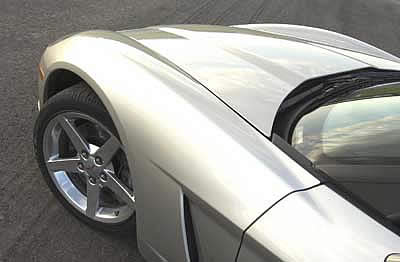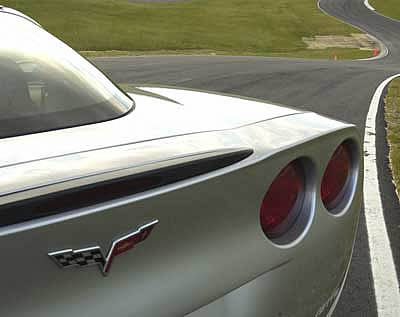Tom Peters Interview: Design of the 2005 Corvette C6 - Page 1 of 2
 |
Tom Peters: The Follow-Up Interview - Page 1 of 2
by Hib Halverson
©2004 Corvette Action Center
No use without permission
Released: August 1, 2004
Prior to our second interview with Tom Peters, Rob Loszewski, Site Administrator of the Corvette Action Center ran a thread in the forums asking members to submit questions for Peters. Of those submitted, I picked the two best questions and presented them to Tom as our first two follow-ups.
CAC: Why was the third brake light not integrated into the rear fascia as it was on some C4s and C5?
TP: "It was part thematic and part aerodynamic. Just like the front, rather than going straight across, we wanted to create this "center fuselage" with the fender forms. Visualize the hood and the hood cut line that separates the fender shapes from the hood shape. I wanted to carry that consistently in the rear, too. Remember, I pointed out to you that line which sweeps through that cut line on the hood, goes through the belt (line), tracks back next to the backlight (rear window) and, then, into the spoiler?"
"I wanted to do everything I could to create the rear as horizontal as possible and not as tall and thick like C5. So, (the third brake light) added to that. If you look at the dead-rear profile, it's lower in the center, underneath the CHMSL (center high-mounted stop light-auto industry people call it a "chimzel") and, then it kind of "dihedrals" goes up into the fender shapes."
"Aerodynamics required that center rear be higher. The top of the CHMSL is virtually the same height as today's C5 because that is exactly where the tunnel wants it to be to minimize drag."
"I thought that, thematically and proportionally, I didn't want to add weight to that. Originally, the CHMSL, instead of an accent color with a lens-shaped cutout, was all a piece of red lens. We found out in crash (testing) that when you stroke (cause the surface to deform) that area of the fascia, the lens got scuffed. The law (FVMSS) states it can't be damaged at all. It can't even be scuffed, so (the all-lens CHMSL) was a no-build (couldn't go to production). We went with an accent color because I didn't want to go body color 'cause, to me, it added visual height and didn't want to do that."
"From what I understand, in the later crash tests, it is not getting damaged so, I don't know if they're going to do it in the first year of production, but maybe they might be doing some SPO (Service Part Operations, GM's replacement and aftermarket parts organization) things and then, maybe later, go back to an all lens CHMSL, but I'm not sure."
CAC: The SPO folks told us that they already have that assembly in body color rather than gray.
TP: "But, you know, when you put that on, you get a rear view that looks kind of funny. You don't see that dihedral transition. You see this body colored bump, so from a design perspective, I'm not sure I support that."
CAC: I'm anxious to see what the body color one looks like.
TP: "I know there's one floating around. Harlan Charles (Asst. Corvette Brand Manager) has a car with it. I haven't stood back and looked at it because I haven't seen that car outside, but I know people who've seen it and say it's doesn't look the same; it doesn't look like the initial intent, which was to have a little bit of accent going across with the fender shapes kinda flying off."
"Remember, I talked about tension? Another thing: design wise, from sideview or top-three-quarter, your eye goes back to that spoiler detail. It's a way to create, visually, my idea of drawing-back-the-bow or a kind of a tight, tension-oriented profile. The gray accented CHMSL is a visual detail which supports that feeling of tension going through the car."
"In the end, passionate Corvette customers are going to make individual judgment calls."
CAC: Given all the controversy surrounding the initial design of the C6 front license plate mount, what were some of the challenges you experienced in trying to develop an asthetically pleasing, yet functional design for the front plate?
TP: "Initially, I didn't want a plate box (like C4 and C5) just cut in there. It would have been in the wrong location and just made the design unbalanced. I made the decision to give the customer the option to either put it on or take it off. The challenges were how do you: 1) frame the license plate so it looks integrated? 2) do it in a way which does not obstruct the aerodynamics and 3) not restrict cooling flow into the center port?"
"Some people say, 'Why didn't you lower it? Why didn't you put it in that opening?' Well, you can't because of legal requirements (Federal Motor Vehicle Safety Standards or 'FVMSS' along with balkanized state laws relating to license plate positioning). It, also, negatively affects aero because you're putting up another flat surface, which, again, is not directionally-correct aerodynamically. We couldn't lower it because that restricts airflow into the center port which was key to cooling and engine breathing."
"Some people are frustrated because we didn't integrate it into the shape. The accent line is a little higher than C5 but, since we have a center-port opening, that created a whole different set of problems. We'd have lost some of the purity of the design and the frame would have been in the wrong location."
"We knew we had to have a standup bracket, one that would be in keeping with the Corvette character and the car's refinement. We struggled with this. We had X-amount of dollars to put into it and we also wanted to have it body color. The other part that's a challenge is the attachment scheme. You don't want to be punching holes in the fascia. Engineers prefer mechanical fasteners and are working on a solution which will avoid visible holes in the fascia."
"It was a choice I made which I still stand behind and, when I get one of these cars; I'm not going to put a license plate on the front. I might have it in the car and if I get stopped, I'll deal with that when it happens. I know in some states, they're getting really hard-assed about it."
 |


